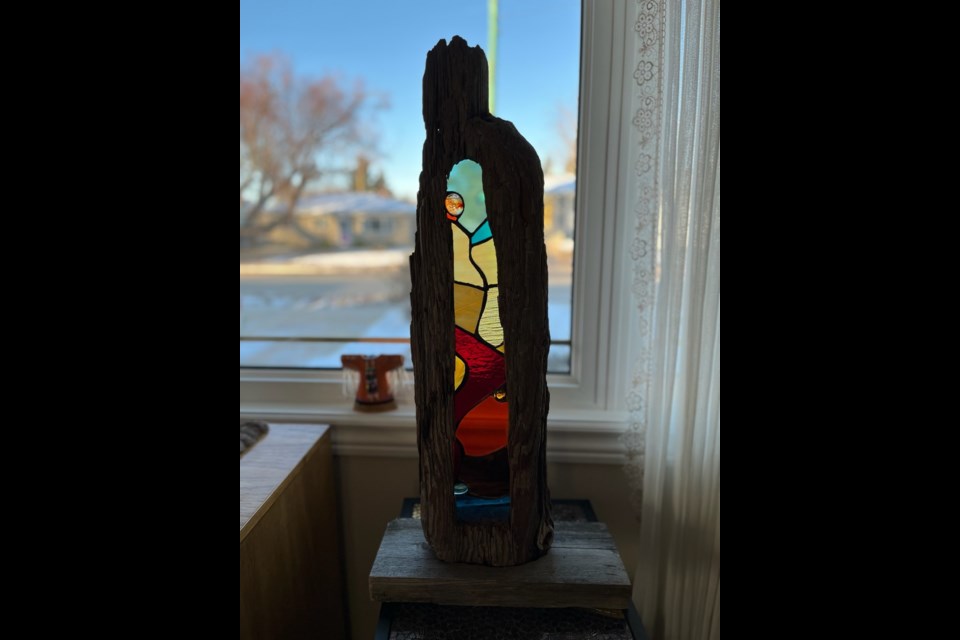Stained glass can be a challenging medium to work with. Despite the defiant nature of the craft, local artist Phyllis Hildebrandt made it her medium of choice. She delights in the challenge of creating something meaningful, and her work brings her art and her background together in a vibrant, colourful, and eye-catching manner.
Hildebrandt will be showcasing her work at the upcoming ‘Glass Art Daydream’ exhibit at the Moose Jaw Cultural Centre starting Jan. 17, 2024.
“I have about 20 pieces to show (at the exhibit). It’s going to be set up on Jan. 16 (2024), and (the exhibition will run) to Feb. 28 (2024),” Hildebrandt said. The show will start the following day on Jan. 17, 2024.
Most of her works at the exhibit will be for sale. Hildebrandt doesn’t currently have a website, so most of her sales are conducted by word of mouth or at an event such as this.
One of these pieces is called ‘Plight of the Salmon,’ which is part of her driftwood collection.
“They don’t look too well – they’re not looking too healthy,” she said about the salmon in the piece. Hildebrandt said this is deliberate and sends a valuable message: salmon are going through a real-world struggle.
“Because I’m from B.C., I’m aware of the decline of the salmon. The streams are drying up, and there’s not enough water (in some spawning areas),” she said.
Originally from Nak’azdli First Nation in the northern interior of B.C., she says, “I’ve always been interested in art from when I was little, but I never really pursued it until after I retired. I didn’t have the time.”
Hildebrandt first came to Moose Jaw around 1972. Now that she’s retired, she has time for her art.
“In 2014 I took a beginner’s class. I always wanted to do it and thought well, I might as well go for it now that I’m retired, and I’ve got lots of time now to do stuff like that,” recalled Hildebrandt. “I’ve been doing it ever since.”
A few of her creations include Edwardian cases that are similar to a terrarium, pictures, flowerpots, and around three totem poles so far.
Hildebrandt finds inspiration from a deep-rooted connection with her culture. “I would say I’m inspired by my culture – by the Aboriginal culture,” she said, “and by nature.” This inspiration helps her navigate the tedious details and less cooperative aspects of the medium.
“Well, I’m always cutting myself, of course,” she said. “You get little glass slivers in your hand (too). You just have to make sure you have bandages (handy).
“Sometimes it gets frustrating, because you want a certain shape, and the glass sometimes breaks where it wants to break. It has its own mind it seems,” she added. Hildebrandt then reuses as much of this excess material as she can in other pieces.
To make a stained-glass piece, artisans purchase specialized coloured glass from a dealer.
“First, you need to know what you’re going to make and have a plan in mind,” she advised. “Then, you select whatever colours you want to work with.”
To source this glass, several small business suppliers are available but sometimes travel is required.
“Moose Jaw has an outlet at ‘Glass with Class.’ She has glass there, but I also find some when I’m in Edmonton or Winnipeg. I always check out the stained-glass stores and stock up on glass,” she said. It can be challenging to find this glass in general, so she’s always on the lookout.
“There aren’t too many places that sell glass. There was a place in Regina, but they’ve closed down. Another guy has (recently) opened up… but I haven’t shopped there all that much yet.”
Glass suppliers sell a ready-made sheet that has been melted down and flattened. Bumps and ridges make the glass harder to cut, so this is a crucial and delicate task.
“After you’ve cut your glass, you have to grind the edges on a grinder just to smooth it out. Then you put foil on it. It’s a copper foil, and it’s sticky on the one side. It sticks to the edges of your glass, and that’s what the solder sticks to,” she explained. This is followed by soldering the foil-covered edges together to complete the work.
Her creations take anywhere from a single day to around three months to complete.
“I have one Edwardian case that took me three months to do, called ‘A Crystal Palace.’ It’s quite big. That was probably the most time-consuming piece I’ve done,” Hildebrandt said.
Hildebrandt has invited everyone interested in her works to her upcoming exhibition at the Moose Jaw Cultural Centre starting Jan. 17, 2024.
The official artist’s reception will take place on Jan. 20, 2024, and runs from 2 – 4 p.m. At the reception, Hildebrandt will be available to answer questions and guests are given the opportunity to meet the artist behind the works.
The Moose Jaw Cultural Centre is located at 217 Main Street North and can be reached at 306-693-4700.
In response to some providers blocking access to Canadian news on their platforms, our website, MooseJawToday.com will continue to be your source for hyper-local Moose Jaw news. Bookmark MooseJawToday.com and sign up for our free online newsletter to read the latest local developments.




